In Situ Synthesis of MoSi2-SiC Composites by Two-Step Spark Plasma Sintering
Abstract
1. Introduction
2. Experimental Procedures
2.1. Sample Fabrication
2.2. Sample Characterization
3. Result and Discussion
3.1. Thermodynamics of MoSi2-SiC System
3.2. Phase Identification
3.3. Behavior of Sintering
3.4. Microstructure of Composites
3.5. Mechanical Properties
3.6. Comparison of Mechanical Properties
3.7. Electrical Properties
4. Conclusions
Author Contributions
Funding
Data Availability Statement
Acknowledgments
Conflicts of Interest
References
- Ramasesha, S.K.; Tantri, P.S.; Bhattacharya, A.K. MoSi2 and MoSi2-Based Materials as Structural Ceramics. Met. Mater. Process. 2000, 12, 181–190. [Google Scholar]
- Tantri, P.S.; Bhattacharya, A.K.; Ramasesha, S.K. Synthesis and properties of MoSi2 based engineering ceramics. J. Chem. Sci. 2001, 113, 633–649. [Google Scholar] [CrossRef]
- Pan, Y.; Wang, S. Insight into the oxidation mechanism of MoSi2: Ab-initio calculations. Ceram. Int. 2018, 44, 19583–19589. [Google Scholar] [CrossRef]
- Cao, L.; Bai, Z.; Huang, J.; OuYang, H.; Li, C.; Wang, B.; Yao, C. Fabrication of gradient C/C-SiC-MoSi2 composites with enhanced ablation performance. Ceram. Int. 2016, 42, 12289–12296. [Google Scholar] [CrossRef]
- Ding, Z.; Brouwer, J.C.; Zhu, J.-N.; Popovich, V.; Hermans, M.J.; Sloof, W.G. Effects of boron addition on the high temperature oxidation of MoSi2 alloys. Scr. Mater. 2023, 234, 115580. [Google Scholar] [CrossRef]
- Yan, J.-h.; Xu, J.-j.; Wang, Y.; Liu, L.-F. Preparation of agglomerated powders for air plasma spraying MoSi2 coating. Ceram. Int. 2015, 41, 10547–10556. [Google Scholar] [CrossRef]
- Zhang, Y.; Li, Y.; Bai, C. Microstructure and oxidation behavior of Si–MoSi2 functionally graded coating on Mo substrate. Ceram. Int. 2017, 43, 6250–6256. [Google Scholar] [CrossRef]
- Yan, J.; Wang, Y.; Liu, L.; Wang, Y. Oxidation and interdiffusion behavior of Niobium substrate coated MoSi2 coating prepared by spark plasma sintering. Appl. Surf. Sci. 2014, 320, 791–797. [Google Scholar] [CrossRef]
- Erfanmanesh, M.; Bakhshi, S.R.; Khajelakzay, M.; Salekbafghi, M. The effect of argon shielding gas at plasma spray process on the structure and properties of MoSi2 coating. Ceram. Int. 2014, 40, 4529–4533. [Google Scholar] [CrossRef]
- Shan, A.; Fang, W.; Hashimoto, H.; Park, Y.-H. Effect of Mg addition on the microstructure and mechanical properties of MoSi2 alloys. Scr. Mater. 2002, 46, 645–648. [Google Scholar] [CrossRef]
- Wen, S.; Sha, J. Improvement of “Pest” Resistance of MoSi2 Intermetallic Compound at 500 °C and 600 °C via Addition of B Fabricated by Spark Plasma Sintering. Oxid. Met. 2019, 92, 243–257. [Google Scholar] [CrossRef]
- Zhang, H.; Lv, J.; Zhuang, S.; Chen, Y.; Gu, S. Effect of WSi2 and Si3N4 contents on the thermal expansion behaviors of (Mo,W) Si2-Si3N4 composites. Ceram. Int. 2017, 43, 2847–2852. [Google Scholar] [CrossRef]
- Nie, X.; Lu, Q. Fracture toughness of ZrO2–SiC/MoSi2 composite ceramics prepared by powder metallurgy. Ceram. Int. 2021, 47, 19700–19708. [Google Scholar] [CrossRef]
- Zhu, G.; Wang, X.; Feng, P.; Li, D.; Yang, T.; Akhtar, F. Synthesis, microstructure and mechanical properties of (Mo,Ti) Si2/Al2O3 composites prepared by thermite-reaction-assisted combustion synthesis. J. Alloys Compd. 2016, 688, 870–877. [Google Scholar] [CrossRef]
- Zhu, M.; Zhang, L.; Li, N.; Cheng, D.; Zhang, J.; Yu, S.; Bai, H.; Ma, H. Microstructures and mechanical properties of reactive spark plasma-sintered ZrB2–SiC–MoSi2 composites. Ceram. Int. 2022, 48, 27401–27408. [Google Scholar] [CrossRef]
- Xu, J.; Wu, H.; Li, B. Synthesis of MoSi2/WSi2 nanocrystalline powder by mechanical-assistant combustion synthesis method. Int. J. Refract. Met. Hard Mater. 2010, 28, 217–220. [Google Scholar] [CrossRef]
- Li, W.; Fan, J.; Fan, Y.; Xiao, L.; Cheng, H. MoSi2/(Mo,Ti) Si2 dual-phase composite coating for oxidation protection of molybdenum alloy. J. Alloys Compd. 2018, 740, 711–718. [Google Scholar] [CrossRef]
- Ko, I.-Y.; Kang, H.-S.; Doh, J.-M.; Yoon, J.-K.; Shon, I.-J. Properties and densification of nanocrystalline MoSi2–Si3N4 composite from mechanically alloyed powders by pulsed current-activated sintering. J. Alloys Compd. 2010, 502, L10–L13. [Google Scholar] [CrossRef]
- Peng, K.; Han, G.; Li, J.; Wang, L.; Zhang, W.; Wang, W.; Zhang, J. Anti-oxidation properties and phase composition evolution of the MoSi2-HfO2 duplex bond coat in air and steam/oxygen atmosphere at 1450 °C. Surf. Coat. Technol. 2024, 492, 131235. [Google Scholar] [CrossRef]
- Chen, P.; Zhu, L.; Ren, X.; Kang, X.; Wang, X.; Feng, P. Preparation of oxidation protective MoSi2–SiC coating on graphite using recycled waste MoSi2 by one-step spark plasma sintering method. Ceram. Int. 2019, 45, 22040–22046. [Google Scholar] [CrossRef]
- Wang, X.; Gao, X.; Zhang, Z.; Cheng, L.; Ma, H.; Yang, W. Advances in modifications and high-temperature applications of silicon carbide ceramic matrix composites in aerospace: A focused review. J. Eur. Ceram. Soc. 2021, 41, 4671–4688. [Google Scholar] [CrossRef]
- Zhang, X.; Lu, Z.; Jin, Z. Electrical resistivity and microstructure of pressureless reactive sintered MoSi2–SiC composite. Mater. Chem. Phys. 2004, 86, 16–20. [Google Scholar] [CrossRef]
- Esmaeily, S.; Kermani, M.; Razavi, M.; Rahimipour, M.R.; Zakeri, M. An investigation on the in situ synthesis–sintering and mechanical properties of MoSi2–xSiC composites prepared by spark plasma sintering. Int. J. Refract. Met. Hard Mater. 2015, 48, 263–271. [Google Scholar] [CrossRef]
- Chen, F.; Xu, J.; Hou, Z. In situ pressureless sintering of SiC/MoSi2 composites. Ceram. Int. 2012, 38, 2767–2772. [Google Scholar] [CrossRef]
- Peng, K.; Yi, M.; Ran, L.; Ge, Y. Reactive hot pressing of SiC/MoSi2 nanocomposites. J. Am. Ceram. Soc. 2007, 90, 3708–3711. [Google Scholar] [CrossRef]
- He, Z.-b.; Li, H.-j.; Shi, X.-h.; Fu, Q.-g.; Heng, W. Formation mechanism and oxidation behavior of MoSi2–SiC protective coating prepared by chemical vapor infiltration/reaction. Trans. Nonferrous Met. Soc. China 2013, 23, 2100–2106. [Google Scholar] [CrossRef]
- Zakeri, M.; Yazdani-Rad, R.; Enayati, M.; Rahimipour, M. Synthesis of nanocrystalline MoSi2 by mechanical alloying. J. Alloys Compd. 2005, 403, 258–261. [Google Scholar] [CrossRef]
- Guo, S.-Q.; Nishimura, T.; Mizuguchi, T.; Kagawa, Y. Mechanical properties of hot-pressed ZrB2–MoSi2–SiC composites. J. Eur. Ceram. Soc. 2008, 28, 1891–1898. [Google Scholar] [CrossRef]
- Wang, C.-C.; Li, K.-Z.; He, D.-Y.; Shi, X.-H. Oxidation behavior of plasma-sprayed MoSi2-Yb2O3 composite coating at 1700 °C. Ceram. Int. 2020, 46, 9538–9547. [Google Scholar] [CrossRef]
- Zhu, L.; Zhang, S.; Ye, F.; Ren, X.; Feng, P. Recycling of MoSi2-based industrial solid wastes for the fabrication and high-temperature oxidation behavior of MoSi2–ZrSi2–SiC composite coating. Compos. Part B Eng. 2024, 274, 111281. [Google Scholar] [CrossRef]
- Potanin, A.Y.; Vorotilo, S.; Pogozhev, Y.S.; Rupasov, S.; Lobova, T.; Levashov, E. Influence of mechanical activation of reactive mixtures on the microstructure and properties of SHS-ceramics MoSi2–HfB2–MoB. Ceram. Int. 2019, 45, 20354–20361. [Google Scholar] [CrossRef]
- Cabouro, G.; Chevalier, S.; Gaffet, E.; Grin, Y.; Bernard, F. Reactive sintering of molybdenum disilicide by spark plasma sintering from mechanically activated powder mixtures: Processing parameters and properties. J. Alloys Compd. 2008, 465, 344–355. [Google Scholar] [CrossRef]
- Kermani, M.; Razavi, M.; Rahimipour, M.R.; Zakeri, M. The effect of temperature on the in situ synthesis–sintering and mechanical properties of MoSi2 prepared by spark plasma sintering. J. Alloys Compd. 2014, 585, 229–233. [Google Scholar] [CrossRef]
- Sun, G.-D.; Zhang, G.-H.; Ji, X.-P.; Liu, J.-K.; Zhang, H.; Chou, K.-C. Size-controlled synthesis of nano Mo powders via reduction of commercial MoO3 with carbon black and hydrogen. Int. J. Refract. Met. Hard Mater. 2019, 80, 11–22. [Google Scholar] [CrossRef]
- Xu, J.; Jiang, G.; Li, W.; Zhuang, H.; Zhang, B.; Chen, L. In situ synthesis of SiCW/MoSi2 composite through SPS process. J. Alloys Compd. 2008, 462, 170–174. [Google Scholar] [CrossRef]
- Singh, S.; Bhaskar, R.; Narayanan, K.B.; Kumar, A.; Debnath, K. Development of silicon carbide (SiC)-based composites as microwave-absorbing materials (MAMs): A review. J. Eur. Ceram. Soc. 2024, 44, 7411–7431. [Google Scholar] [CrossRef]
- Anstis, G.; Chantikul, P.; Lawn, B.R.; Marshall, D. A critical evaluation of indentation techniques for measuring fracture toughness: I, direct crack measurements. J. Am. Ceram. Soc. 1981, 64, 533–538. [Google Scholar] [CrossRef]
- Kermani, M.; Razavi, M.; Rahimipour, M.R.; Zakeri, M. The effect of mechanical alloying on microstructure and mechanical properties of MoSi2 prepared by spark plasma sintering. J. Alloys Compd. 2014, 593, 242–249. [Google Scholar] [CrossRef]
- Zhang, J.; Wang, Z.; Luo, J.; Wang, S.; Liang, B.; Chen, W. Microstructure, properties and toughening mechanisms of MoSi2@ ZrO2 core shell composites prepared by spark plasma sintering. Mater. Charact. 2023, 195, 112510. [Google Scholar] [CrossRef]
- Hu, Q.; Luo, P.; Yan, Y. Microstructures and densification of MoSi2–SiC composite by field-activated and pressure-assisted combustion synthesis. J. Alloys Compd. 2009, 468, 136–142. [Google Scholar] [CrossRef]
- Han, X.-x.; Wang, Y.-l.; Xiong, X.; Heng, L.; Chen, Z.-k.; Wei, S. Microstructure, sintering behavior and mechanical properties of SiC/MoSi2 composites by spark plasma sintering. Trans. Nonferrous Met. Soc. China 2018, 28, 957–965. [Google Scholar] [CrossRef]
- Guan, S.; Liang, H.; Liu, Y.; Lin, W.; He, D.; Peng, F. Production of silicon carbide reinforced molybdenum disilicide composites using high-pressure sintering. Ceram. Int. 2020, 46, 23643–23650. [Google Scholar] [CrossRef]
- Nazari, M.; Shakeri, E.; Mohammadi, M. Fabrication and optimization process of mechanical properties of MoSi2 composites reinforced by carbon nanotubes (CNT) using Taguchi method. Ceram. Int. 2024, 50, 25568–25577. [Google Scholar] [CrossRef]
- Xu, J.; Chen, F.; Tan, F. In-situ preparation of SiC–MoSi2 composite by microwave reaction sintering. Ceram. Int. 2012, 38, 6895–6898. [Google Scholar] [CrossRef]
- Oh, D.Y.; Kim, H.C.; Yoon, J.K.; Shon, I.J. One step synthesis of dense MoSi2–SiC composite by high-frequency induction heated combustion and its mechanical properties. J. Alloys Compd. 2005, 395, 174–180. [Google Scholar] [CrossRef]
- Mitra, R.; Mahajan, Y.; Prasad, N.E.; Chiou, W. Processing—Microstructure—Property relationships in reaction hot-pressed MoSi2 and MoSi2/SiCp composites. Mater. Sci. Eng. A 1997, 225, 105–117. [Google Scholar] [CrossRef]
- Wang, J.; Feng, P.; Niu, J.; Guo, R.; Liu, Z.; Akhtar, F. Synthesis, microstructure and properties of MoSi2–5 vol% Al2O3 composites. Ceram. Int. 2014, 40, 16381–16387. [Google Scholar] [CrossRef]
- Kasraee, K.; Tayebifard, S.A. Mechanical and Oxidation Behavior of MoSi2-40wt.% Ti5Si3 Composites Produced by MASHS and SPS. Ceram. Int. 2024, 51, 1888–1899. [Google Scholar] [CrossRef]
- Zhu, G.; Wang, X.; Feng, P.; Liu, Z.; Niu, J.; Akhtar, F. Synthesis and properties of MoSi2–MoB–SiC ceramics. J. Am. Ceram. Soc. 2016, 99, 1147–1150. [Google Scholar] [CrossRef]
- Kim, Y.-W.; Kim, Y.-H.; Kim, K.J. Electrical properties of liquid-phase sintered silicon carbide ceramics: A review. Crit. Rev. Solid State Mater. Sci. 2020, 45, 66–84. [Google Scholar] [CrossRef]
- Kim, Y.; Lee, J.Y.; Cho, M.K.; Ahn, J.-P.; Kim, Y.-W. Electrical resistivity at the micron scale in a polycrystalline SiC ceramic. Ceram. Int. 2021, 47, 27100–27106. [Google Scholar] [CrossRef]
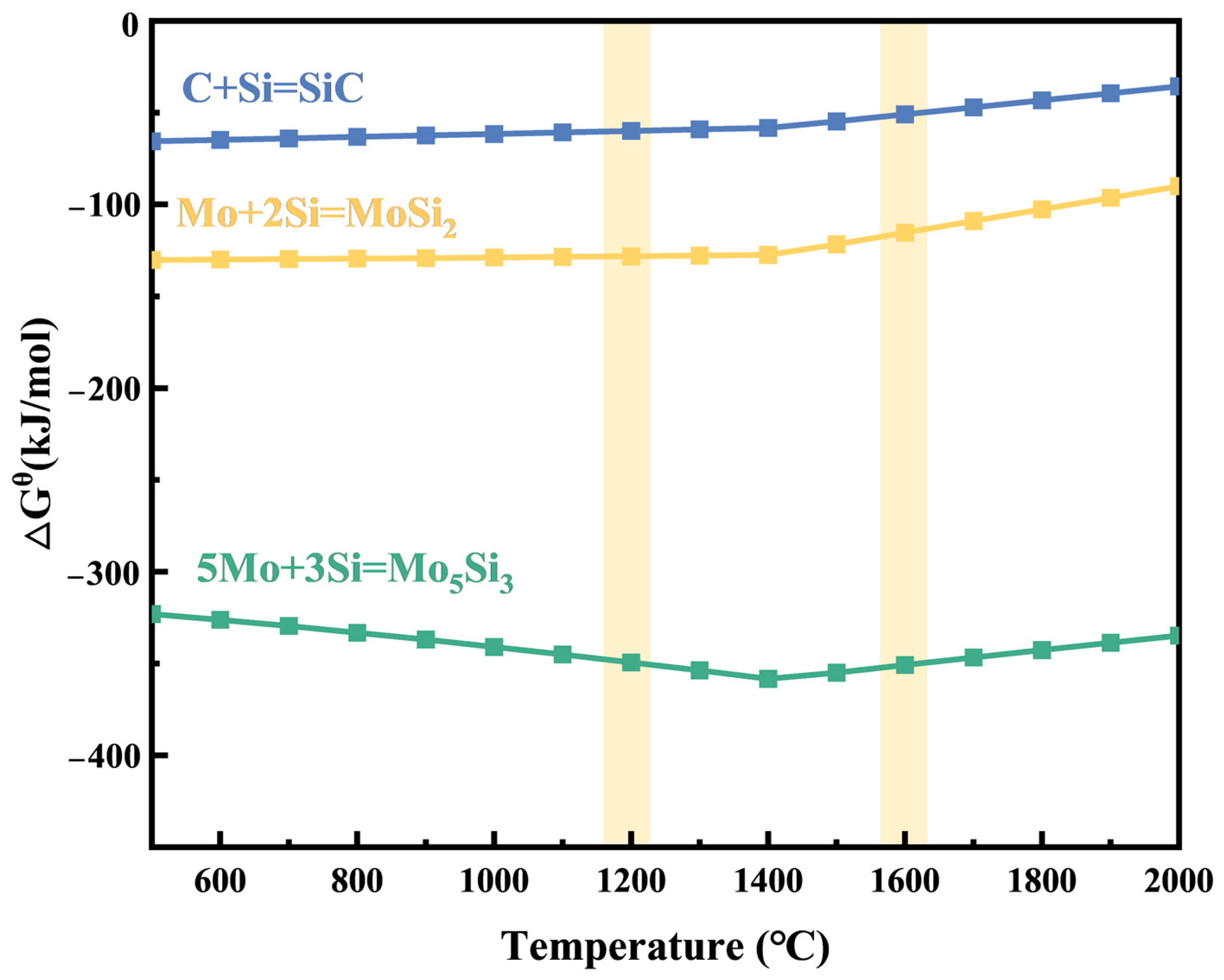
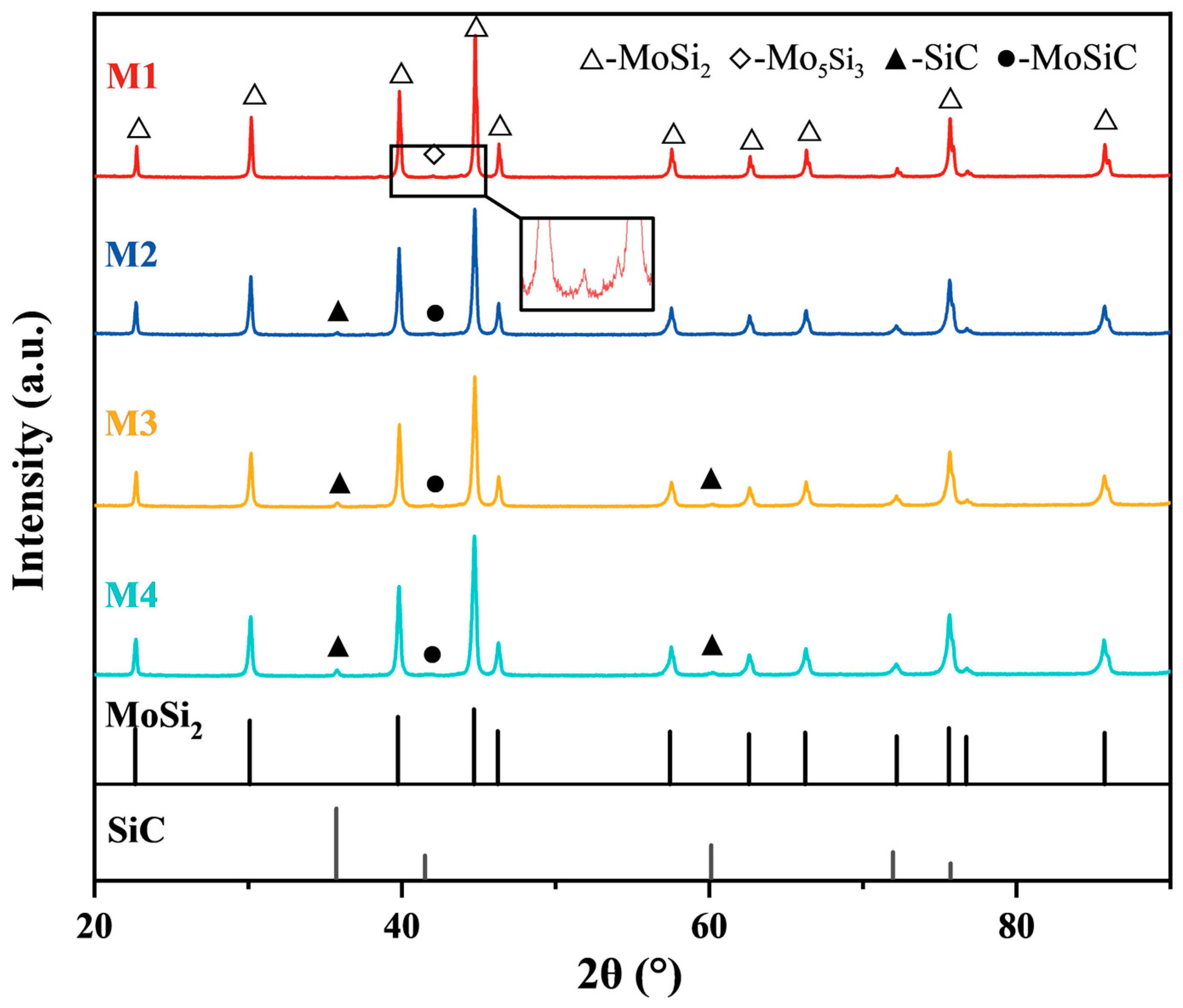
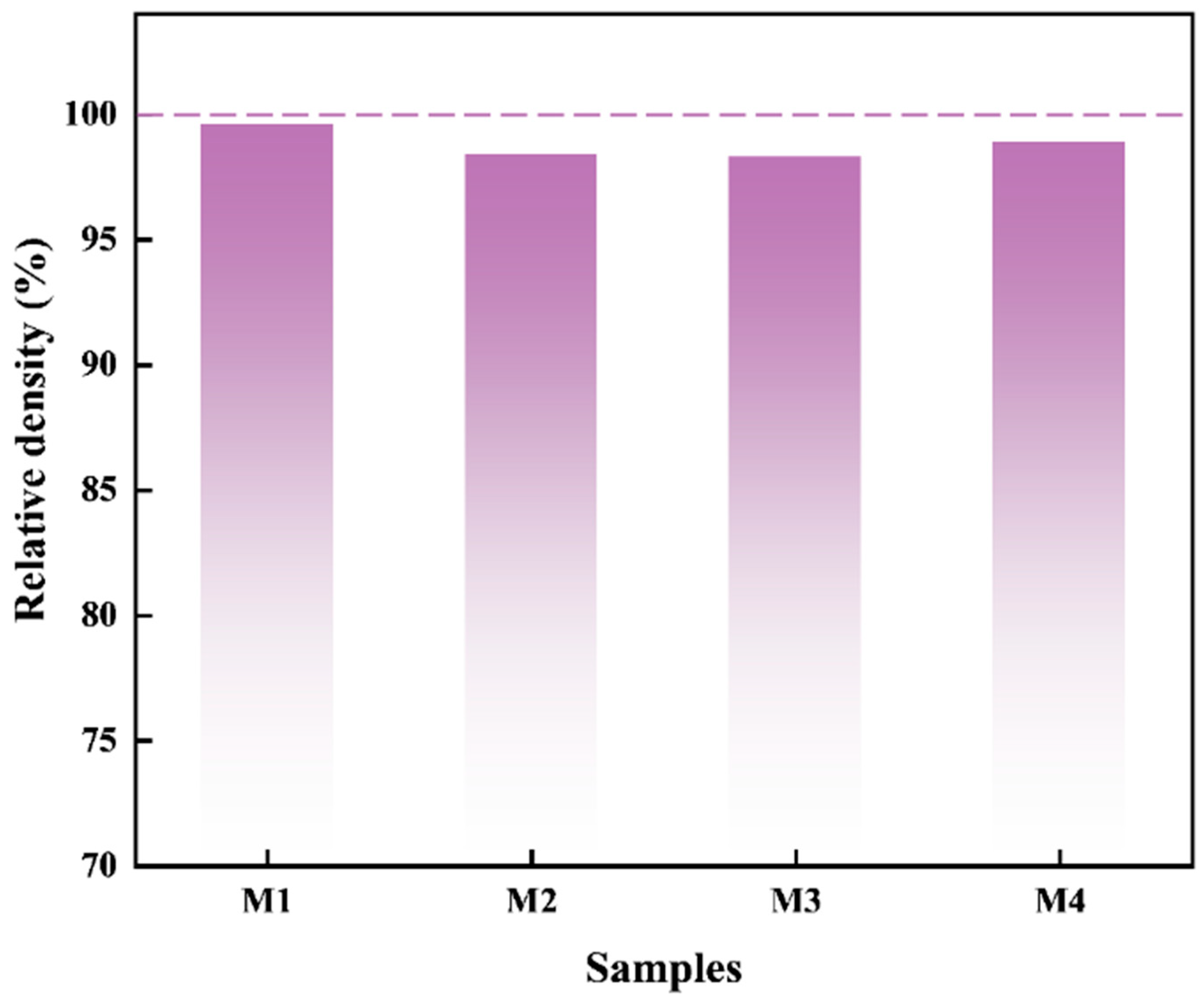



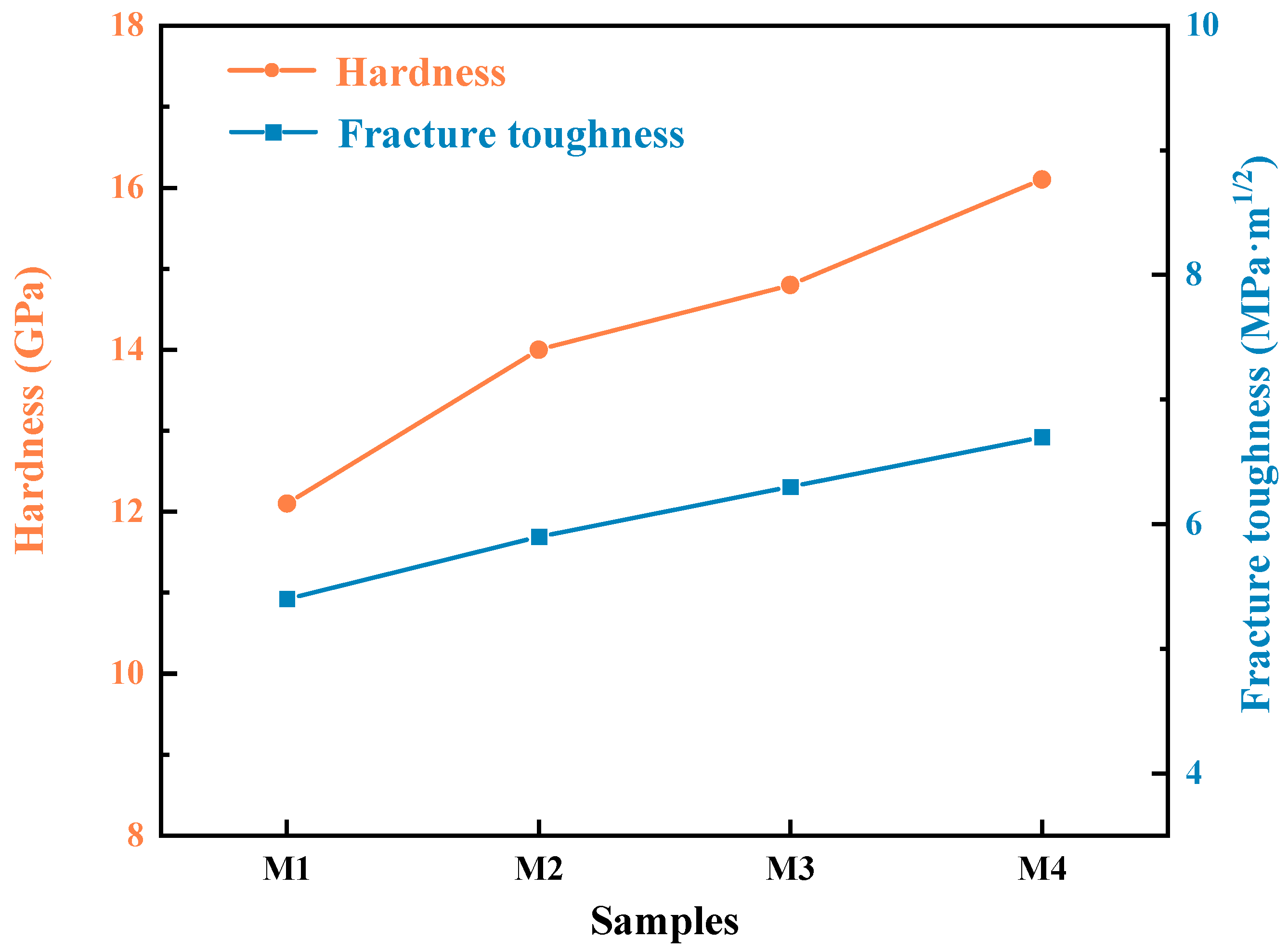
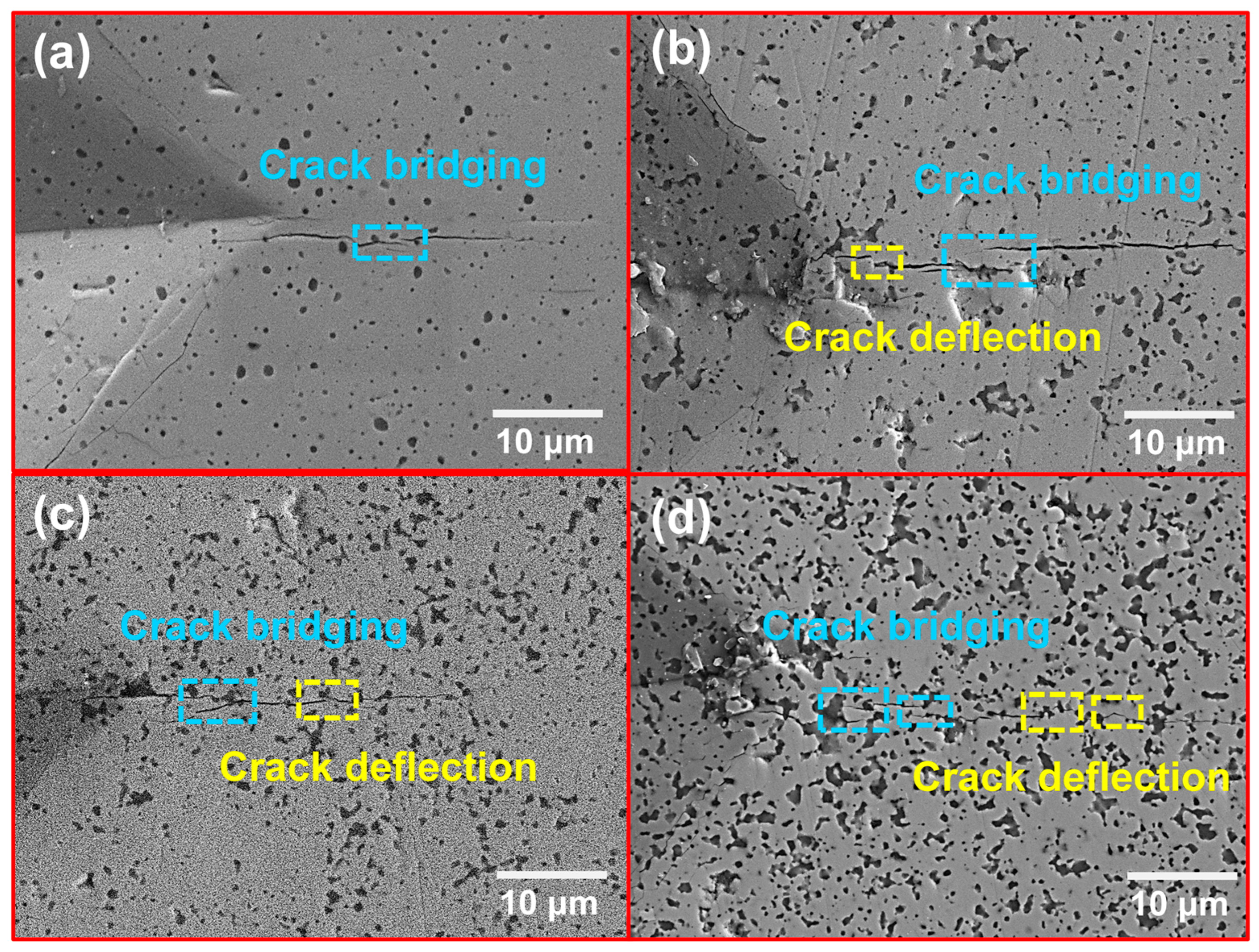
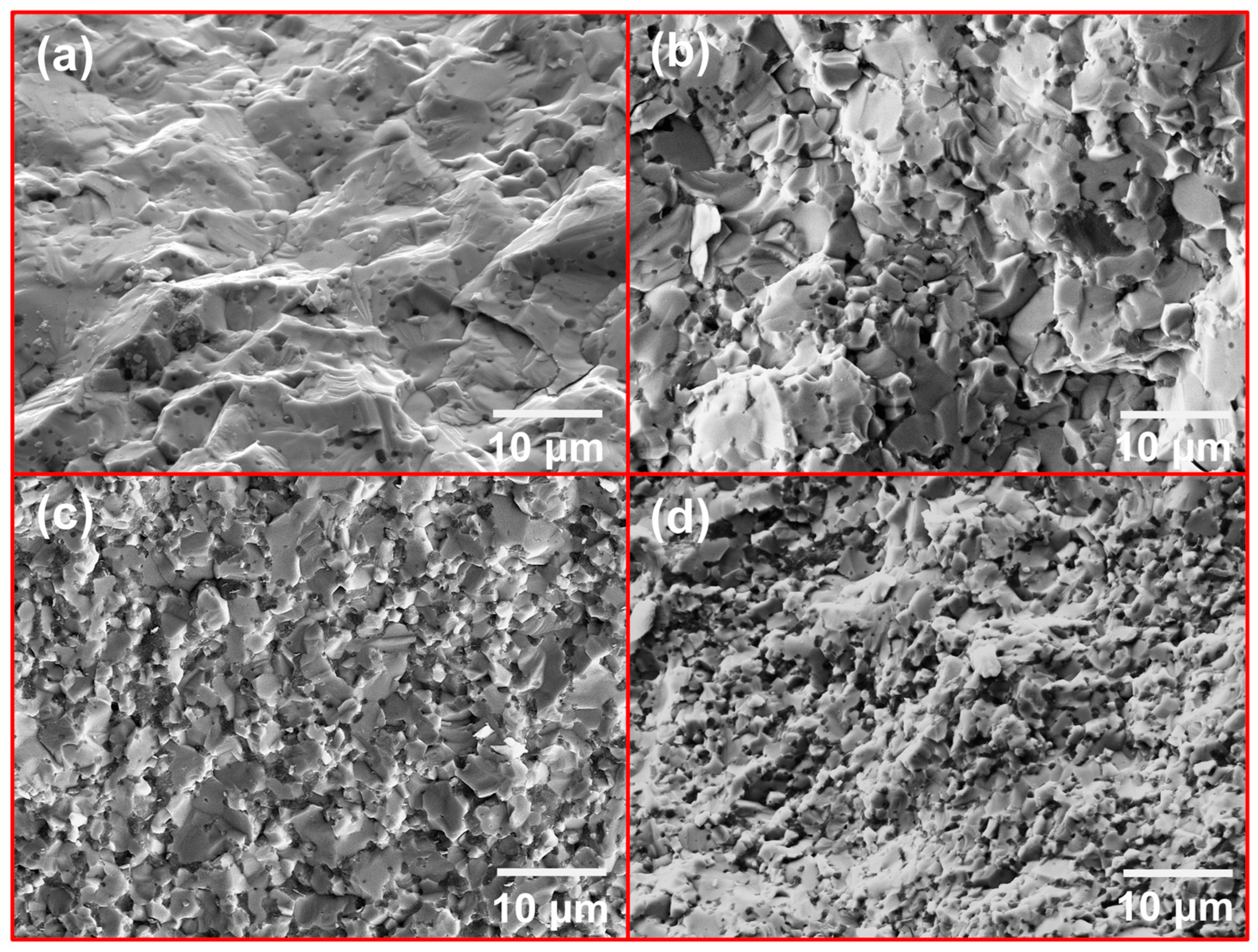

| Sample Number | Mo/wt.% | C/wt.% | Si/wt.% | Materials |
|---|---|---|---|---|
| M1 | 63.07 | - | 36.93 | MoSi2 |
| M2 | 60.95 | 1 | 38.05 | MoSi2-12mol.%SiC |
| M3 | 58.98 | 1.94 | 39.08 | MoSi2-21mol.%SiC |
| M4 | 57.67 | 2.57 | 39.76 | MoSi2-26mol.%SiC |
| Sample | Preparation Method | Relative Density(%) | Vickers Hardness (GPa) | Fracture Toughness (MPa⋅m1/2) | Flexural Strength (MPa) | Reference |
|---|---|---|---|---|---|---|
| M1 | SPS | 99.6 | 12.1 | 5.4 | 387 | - |
| M2 | 98.4 | 14.0 | 5.9 | 474 | - | |
| M3 | 98.3 | 14.8 | 6.3 | 491 | - | |
| M4 | 98.9 | 16.1 | 6.7 | 496 | - | |
| MoSi2-20vol%SiC | Microwave reaction sintering | 91.5 | 7.86 | 8.17 | 251.29 | [44] |
| MoSi2-SiC | High-frequency induction heated combustion | 98 | 13.8 | 4.8 | - | [45] |
| MoSi2-10vol%SiC | Pressureless sintering | 93.1 | 8.843 | 5.5 | 274.5 | [24] |
| MoSi2-SiC | SPS | 97.8 | 13.4 | 5.1 | 674 | [41] |
| MoSi2-20vol%SiC | Hot pressing | 98 | 11.5 | 4.6 | 240 | [46] |
| MoSi2–5vol%Al2O3 | Vacuum hot-pressed sintering | 96.5 | 11.14 | 4.53 | 435 | [47] |
| MoSi2-40wt%Ti5Si3 | SPS | 99 | 10.9 | 5.11 | - | [48] |
| MoSi2-0.4MoB-0.1SiC | Vacuum hot-pressed sintering | 97.5 | 12.5 | 3.8 | 537 | [49] |
| MoSi2-Si3N4 | Pulsed current-activated sintering | 97 | 12 | 6 | - | [18] |
| Sample Number | Electrical Resistivity (µΩ·cm) |
|---|---|
| M1 | 16.8 |
| M2 | 18.9 |
| M3 | 21.5 |
| M4 | 23.3 |
Disclaimer/Publisher’s Note: The statements, opinions and data contained in all publications are solely those of the individual author(s) and contributor(s) and not of MDPI and/or the editor(s). MDPI and/or the editor(s) disclaim responsibility for any injury to people or property resulting from any ideas, methods, instructions or products referred to in the content. |
© 2025 by the authors. Licensee MDPI, Basel, Switzerland. This article is an open access article distributed under the terms and conditions of the Creative Commons Attribution (CC BY) license (https://creativecommons.org/licenses/by/4.0/).
Share and Cite
Wang, Y.-Y.; Zhang, G.-H. In Situ Synthesis of MoSi2-SiC Composites by Two-Step Spark Plasma Sintering. Metals 2025, 15, 144. https://doi.org/10.3390/met15020144
Wang Y-Y, Zhang G-H. In Situ Synthesis of MoSi2-SiC Composites by Two-Step Spark Plasma Sintering. Metals. 2025; 15(2):144. https://doi.org/10.3390/met15020144
Chicago/Turabian StyleWang, Yue-Yao, and Guo-Hua Zhang. 2025. "In Situ Synthesis of MoSi2-SiC Composites by Two-Step Spark Plasma Sintering" Metals 15, no. 2: 144. https://doi.org/10.3390/met15020144
APA StyleWang, Y.-Y., & Zhang, G.-H. (2025). In Situ Synthesis of MoSi2-SiC Composites by Two-Step Spark Plasma Sintering. Metals, 15(2), 144. https://doi.org/10.3390/met15020144







